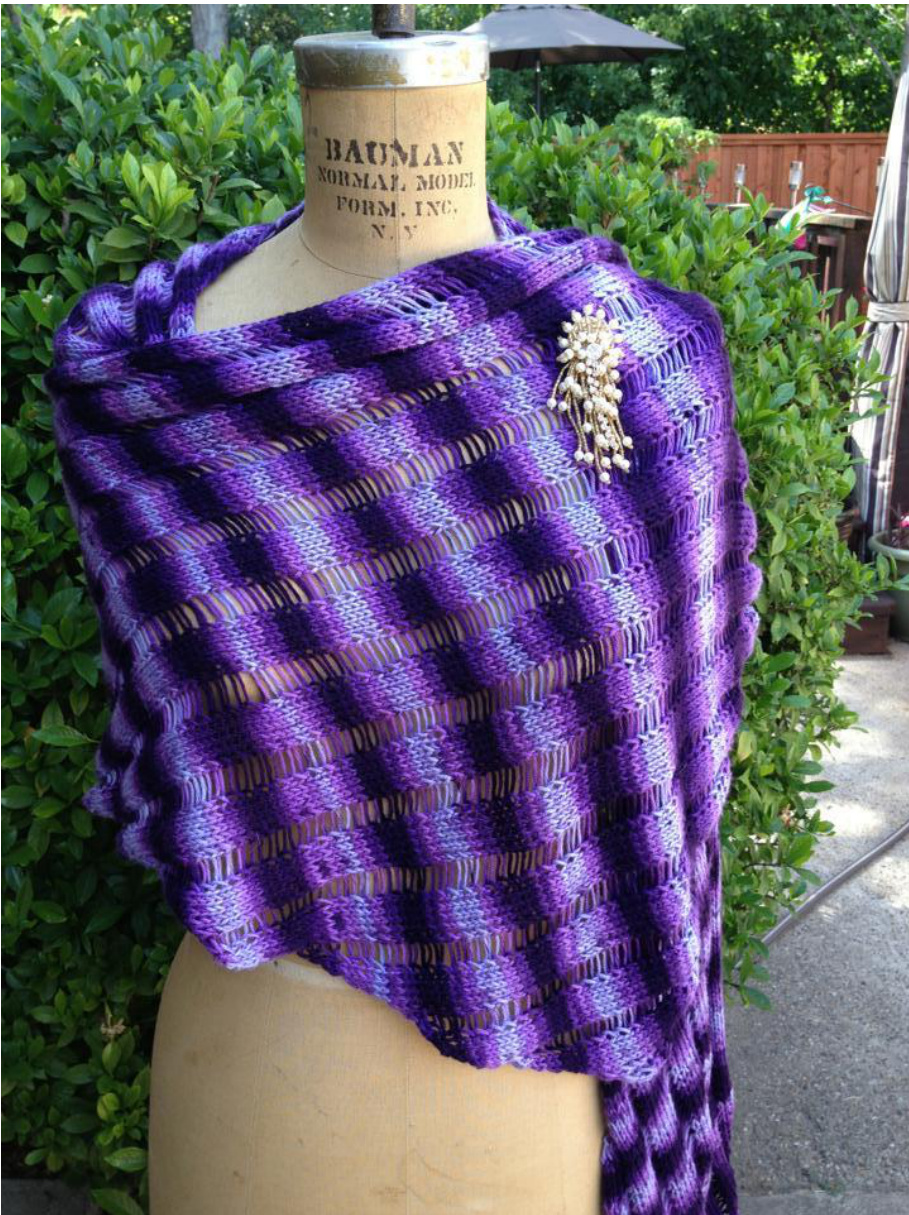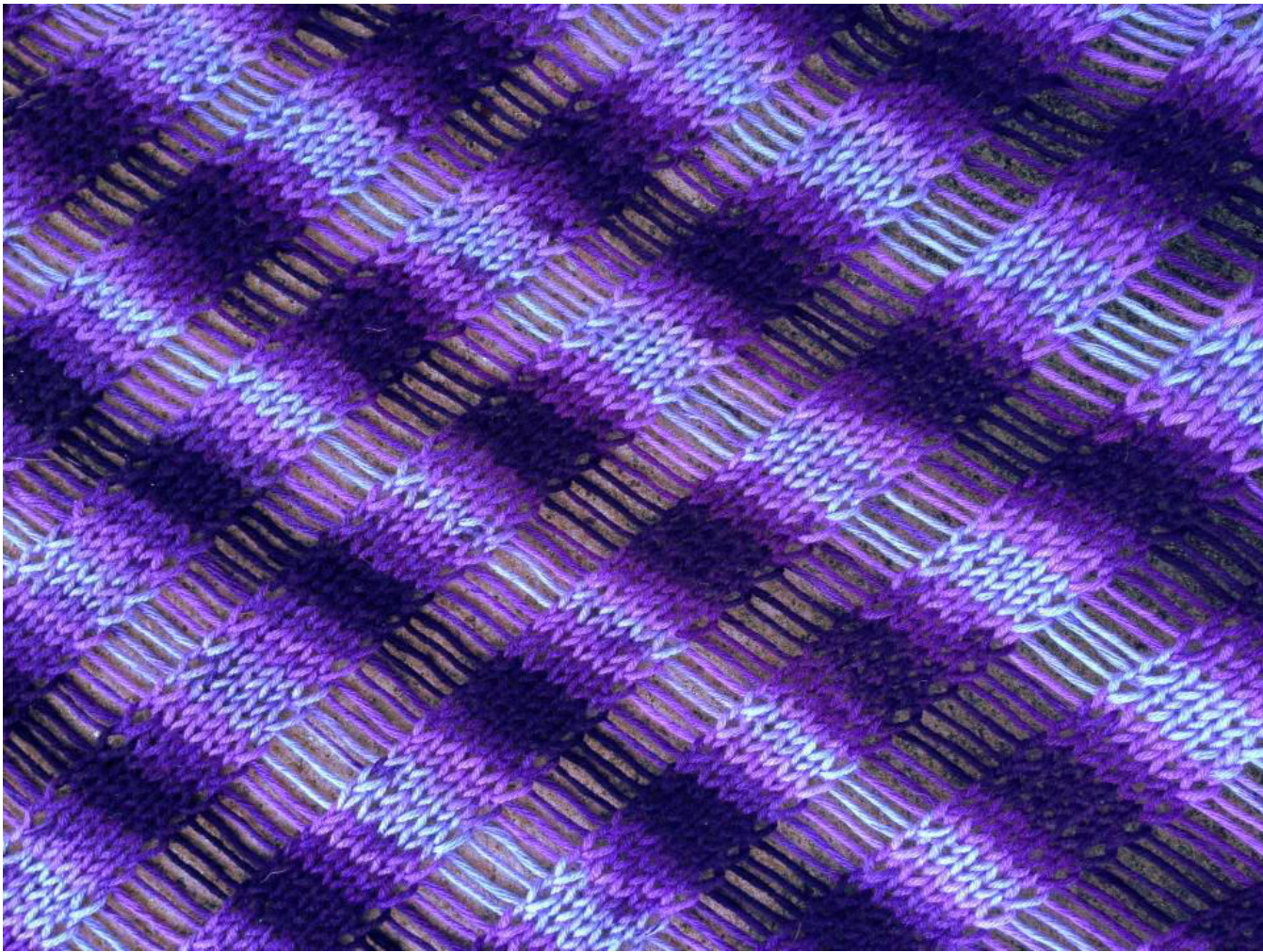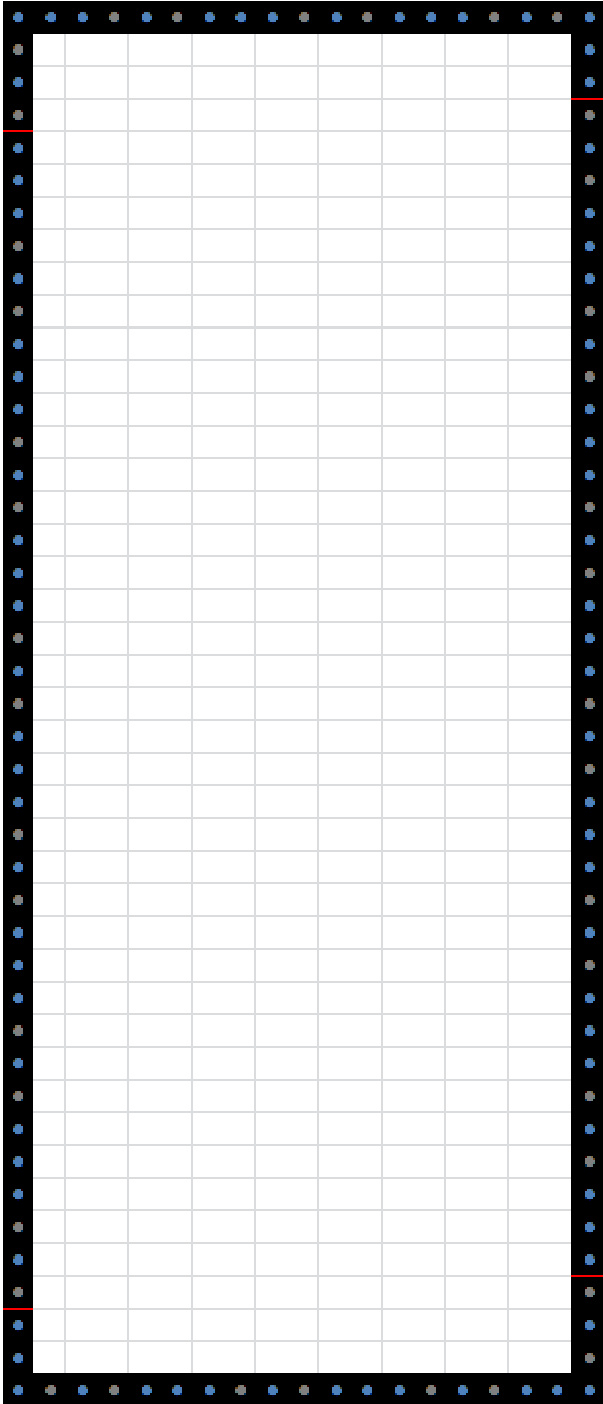CLAPOTIS FOR LOOM KNITTERS
Pattern by Kate Gilbert Translated for loom (with permission) by Charity Windham The Clapotis (French for "lapping of water" and is pronounced clap-o-tee) is the most popular project on Ravelry - ever! With over 20,000 projects and climbing every day. No way I wanted us loom knitters to miss out. The original needle knit pattern (be sure to visit the project pages) can be found here: http://www.ravelry.com/patterns/library/clapotis I also want to give a HUGE shout out to Kate Gilbert for allowing me to share her fantastic pattern with the loom knitting community. Her website, full of her amazing designs can be found at: http://www.kategilbert.com

One Size Fits Most Width: 22 Inches Length: 55 inches
MATERIALS:
Deborah Norville Serenity? Garden: 100% Microfiber (acrylic): color = crocus, Fine Weight, 4 skeins used \*important note when selecting yarn: your item will NEED to be blocked once completed. Take care in selecting a yarn that is 1. Able to be blocked and 2. Is very silky/smooth so that you are able to drop your stitches properly. A yarn with a "halo" or sequins will not work well for this yarn. 3/8" peg spacing loom with a minimum of 107 pegs (Martha Stewart Loom was used for sample) ·LoomTool ·Yarn Needle for weaving in ends ·17 stitch/peg markers GAUGE: 19 sts/25 rows = 4" in stockinette ABBREVIATIONS: CO = Yarn Over Cast On (Yarn Over 2 times, Knit bottom loop over top) K = U-Knit Stitch (you may substitute the traditional knit stitch) E=E-Wrap Stitch SK = Skip this peg (do not work this peg) HH = Half Hitch Increase pm&yo = Place marker and Yarn Over - always worked on an empty peg either before a K2tog or after a SSK (Yarn Over = do not e-wrap, simply place yarn in front of peg) K2tog =Knit 2 together (Move loop from working peg over to the right 1 peg. You should now have 1 peg with 2 loops on the right and an empty peg on the left. The peg with 2 loops is the K2tog peg. The empty peg is the pm&yo peg. Knit the bottom two loops over the top loop. ) SSK =Skip, Skip, Knit (Move loop from peg directly to the right of the working peg over to the working. You should now have 1 peg with 2 loops on the peg to the left and 1 empty peg to the right. The empty peg will be the pm&yo peg. The peg with 2 loops is the ssk peg. Knit the bottom two loops over the top loop on the ssk peg.)
DIRECTIONS:
| SECTION 1 (SET UP ROWS): | |
| CO 2 in center of loom | Stitches on Loom |
| Row 1: k2, HH | 3 |
| *Skip 1st peg of each row for remainder of this section | |
| Row 2: sk1, k1, pm&yo, k1, hh | 5 |
| Row 3 (and all odd # rows): sk1, k to last stitch, hh | 6 |
| Row 4: sk1, k1, e1, k1, e1, k1, hh | 8 |
| Row 6: sk1, k2, e1, k1, e1, k2, hh | 10 |
| Row 8: sk1, k3, e1, k1, e1, k3, hh | 12 |
| Row 10: sk1,k4,e1,k1,e1, k4,hh | 14 |
| Row 12: sk1, k5, e1, k1, e1, k5,hh | 16 |
| Row 14: sk1, k1, pm&yo, k2tog, k3, e1, k1, e1, k3, ssk, pm&yo, k1, hh | 17 |
You should have 17 stitches on your loom now. NOTE: From this point forward, on even numbered rows, you will always be e-wrap knitting the stitch before the marker, U-Knitting the stitch with the marker, and e-wrap knitting the stitch after the marker. The line of stitches that are on the peg with the marker, will later be dropped and unraveled, and the adjacent columns of e-wrapped stitches will stay nice and tight, helping the fabric keep its structure. SECTION 2 (INCREASE ROWS):
| StitchesonLoombyRepeat | |||||||
| *Skip 1st peg of each row for this section | (1) | (2) | (3) | (4) | (5) | (6) | |
| Row1and allodd-numbered rows:sk1,ktolast stitch,hh | 18 | 30 | 42 | 54 | 66 | 78 90 | 102 |
| Row2: sk1, k1, e1, (k1, e1, k3,e1) to last marker, k1, e1, k1, hh | 19 | 31 | 43 | 55 67 | 79 | 91 | 103 |
| Row 4: sk1, k2, e1, (k1, e1, k3,e1) to last marker, k1,e1, k2, hh | 21 | 33 | 45 | 57 69 | 81 | 93 | 105 |
| Row 6: sk1, k3, e1, (k1, e1, k3,e1) to last marker, k1, e1, k3, hh | 23 | 35 | 47 | 59 | 71 | 83 95 | 107 |
| Row 8: sk1, k4, e1, (k1, e1, k3,e1) to last marker, k1, e1, k4, hh | 25 | 37 | 59 | 61 | 73 | 85 97 | |
| Row 10: sk1, k5, e1, (k1, e1, k3, e1) to last marker, k1, e1, k5, hh | 27 | 39 | 51 | 63 | 75 | 87 99 | |
| Row 12: sk1, k1, pm&yo, k2tog, k3, e1, (k1, e1, k3, e1) to last marker, 29 k1, e1, k3, ssk, pm&yo, k1, hh | 41 | 53 | 65 | 77 | 89 101 | ||
Repeat Increase Rows 1 - 12 six (6) more times. End of IncreaseRows=29stitches onloom End of Increase Rows Repeat 1 = 41 stitches on loom End of Increase Rows Repeat 2 = 53 stitches on loom End of Increase Rows Repeat 3 = 65stitches on loom End of Increase Rows Repeat 4 = 77 stitches on loom End of Increase Rows Repeat 5 = 89 stitches on loom End of Increase Rows Repeat 6 = 101 stitches on loom Repeat Increase Rows 1 - 6 once more. 107 stitches on loom.
SECTION 3 (STRAIGHT ROWS):
| StitchesOn Loom | |
| *DO NoT Skip 1"t peg of each row for this section on even numbered rows Row 1 and all odd-numbered rows: sk1, k to last 2 sts, k2tog | 106 |
| Row 2:P1, k2, e1,(k1, e1,k3,e1) to last marker, k1,e1, k4, hh | 107 |
| Row 4:P1, k1, e1,(k1, e1,k3,e1) to last marker, k1,e1, k5, hh | 107 |
| Row 6: P1,e1, (k1, e1, k3, e1) to last marker, k1, e1, k3, ssk, pm&yo, k1, hh Row 8:P1,remove marker,drop next stitch,letit drop down several rows, pick up top bar | 107 107 |
| with loom tooland placebackonpeg to form a newewrap stitch,e wrap this newstitch, e1,k3, e1, [k1, e1, k3, e1] to last marker, k1, e1, k1 hh | |
| Row 10:P1,k4,e1,[k1,e1,k3,e1]tolast marker,k1,e1,k2,hh | 107 |
| Row 12:P1,k3,e1,[k1,e1,k3,e1]to last marker,k1,e1,k3,hh | 107 |
Repeat Straight Rows 1-12, twelve (12) more times. 107 stitches on loom.
SECTION 4 (DECREASE ROWS)
| StitchesonLoombyRepeat | ||||||
| *DONOT Skip1"t peg of each row forthis sectionon even | (1) | (2)(3)(4)(5)(6) | ||||
| numberedrows. Row 1 and all odd-numbered rows: sk1, K to last 2 stitches,k2tog | 106 | 94 | 82 | 70 58 46 | 34 22 | |
| Row2: P1, k2, e1, [k1, e1, k3, e1] to last marker, k1, e1, k2, ssk. | 105 | 93 | 81 | 69 57 45 | 33 21 | |
| Row 4: P1, k1, e1, [k1, e1, k3, e1] to last marker, k1, e1,k1, ssk | 103 | 91 | 79 | 67 55 43 | 31 19 | |
| Row 6: P1, e1,[k1,e1,k3, e1] to last marker, k1, e1, ssk | 101 | 89 | 77 | 65 53 41 | 29 17 | |
Row 8: P1, remove marker, drop next stitch, let it drop down several rows, pick up top bar with loom tool and place back on peg to form a new e wrap stitch, e wrap this new stitch, e1, k3, e1, [k1, e1, k3, e1] to last marker, drop next st and form new st as for previous dropped st, e1, ssk. Row 10: P1, k4, e1, [k1, e1, k3, e1] to last marker, remove marker, ssk Row 12: P1, k3, e1, [k1, e1, k3, e1] to last marker, k1, e1, k3, ssk Repeat Decrease Rows 1-12 6 times more. End of Decrease Rows- 95 stitches on loom End of Decrease Rows, Repeat 1 - 83 stitches on loom End of Decrease Rows, Repeat 2 - 71 stitches on loom End of Decrease Rows, Repeat 3 - 59 stitches on loom End of Decrease Rows, Repeat 4 - 47 stitches on loom End of Decrease Rows, Repeat 5 - 35 stitches on loom End of Decrease Rows , Repeat 6 - 23 stitches on loom Repeat Decrease Rows 1-10 once more. 13 sts rem.
SECTION 5 (FINAL ROWS)
| *DoNoT Skip1st peg of each row for this section StitchesonLoom |
| Rows1,3,5,7,&9:Ktolast2sts,k2tog 12 Row 2:P1,k3,e1,k1,e1,k3,ssk 11 |
| Row4:P1,k2,e1,k1,e1,k2,ssk 6 |
| Row6:P1,k1,e1,k1,e1,k1,ssk 7 |
| Row8:P1,e1,k1,e1,ssk |
| 5 Row10:P1,remove marker,drop st(DONoT form anew stthis time),ssk |
| 3 |
| Row 11 (lastrow):k2tog 2 Breakyarnanddrawthroughloopoflaststitch O |

Finish unraveling any drop-stitch ladders that remain unraveled. Weave in ends. Block if desired (scarf can be blocked into a more rectangular shape if desired). Wear it everyday indoors and out and eat a croissant. NOTE: This pattern can easily be adapted for a larger stole or smaller scarf in this way: WorkSet-upRows. Work Increase Rows until piece is desired width. (Measure width along right-hand side of triangle.) Work Increase Rows 1-6 once more before proceeding to Straight Rows. Work Straight Rows until piece is desired length. (Measure length along left-hand side of piece Work Decrease Rows as necessary until 23 sts remain. Work Decrease Rows 1-10 once more. WorkFinal Rows.
Set up of Martha Stewart Loom for this project:
2 - 36 hole straight pieces 2 - 12 hole straight pieces 4 - 6 hold corner pieces 120 small pegs: 80 blue pegs 40 grey pegs Place pegs around loom In the following sequence: 3 blue pegs 1 grey peg 1 blue peg 1 grey peg Until all holes have a peg.

Other loom options:
If your loom has at least: 35 pegs 47 pegs 59 pegs 71 pegs 83 pegs 95 pegs 107 pegs 1 set of increase/decrease rows 2 sets of increase/decrease rows 3 sets of increase/decrease rows 4 sets of increase/decrease rows 5 sets of increase/decrease rows 6 sets of increase/decrease rows 7 sets of increase/decrease rows









